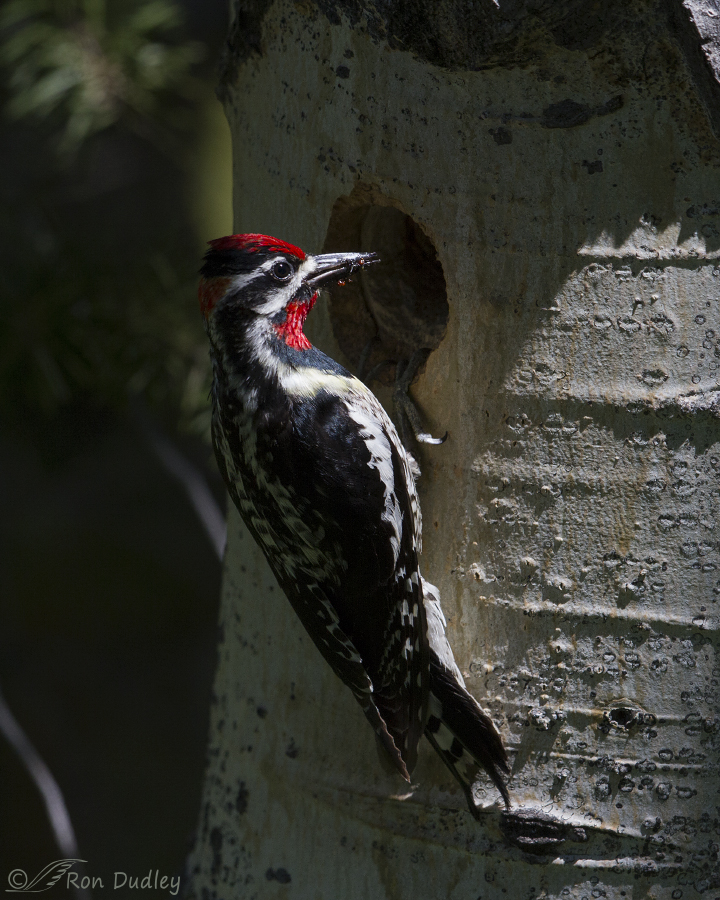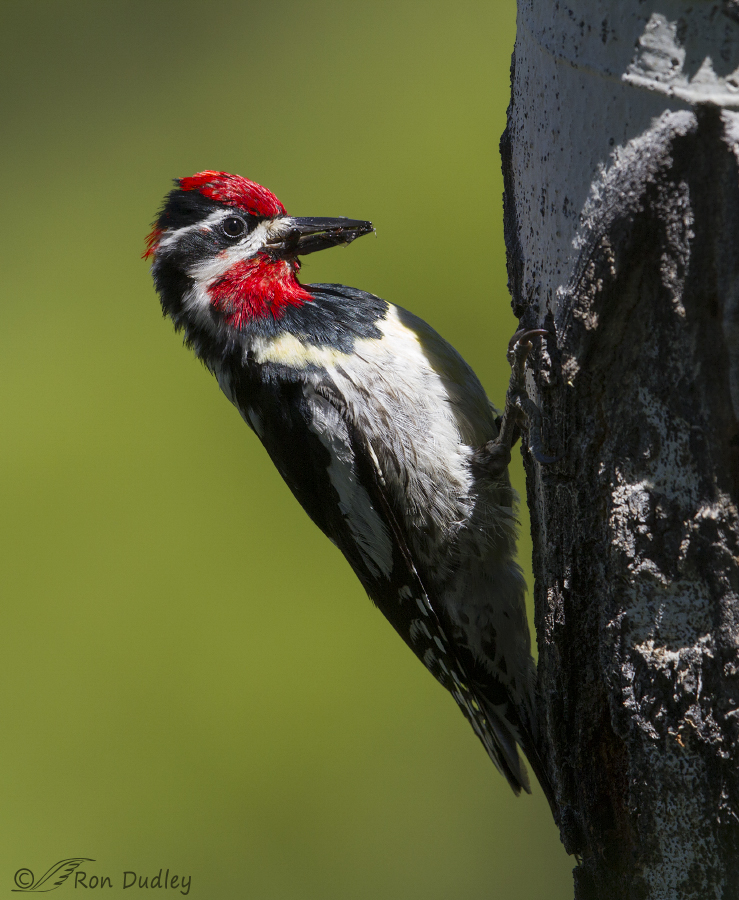On each our Montana trips we try to explore some new country. We found this Red-naped Sapsucker and its mate at their nest-hole on July 1 near a small lake at the end of a long dirt road. It was midday when we found them so the light was a bit harsh and contrasty but because of all the trees and high hills in the area I don’t believe there would be any light at all on the nest-tree in the mornings or evenings.

1/3200, f/5, ISO 800, Canon 7D, Canon EF500mm f/4L IS II USM, not baited, set up or called in
Like its cousins the Williamson’s Sapsuckers that I photographed on the same trip this bird was feeding ants to its youngsters in the nest. The lighting on the bird in this image may not appeal to everyone but I thought it was interesting.

1/1000, f/6.3, ISO 500, Canon 7D, Canon EF500mm f/4L IS II USM, not baited, set up or called in
The light through the leaves was splotchy so the backgrounds always seemed to be very dark or quite bright. I like the perky pose from this adult.
For much of the year these woodpeckers feed primarily at elaborate systems of sap wells that they make and diligently maintain but during nesting season they turn to ants. These birds are incredibly hard workers when it comes to feeding their young. Both parents are involved in feeding the 4-7 youngsters in the nest and between them they make feeding visits as often as every 2 minutes all day long, from dawn to dusk. They often dip the ants in sap before feeding them to their young and in this image you can see ants in the bill and a drop of sap dripping from the lower mandible.
Ron


Just beautiful, Ron! Would love to see a Red-naped! Have never been out West at the right time, I guess.
“masking the bird for sharpening”…Can you please elaborate a little?
Thanks!
SUE
Sue, I nearly always selectively sharpen my images which means that I sharpen only the bird and nothing else in the image. This prevents several negative things from happening including sharpening halos around the subject and an increase in noise in the areas that aren’t sharpened. However, selective sharpening requires that the bird be carefully “masked” first and the process is sometimes laborious and time consuming.
I love these images and the light. Amazing. The clarity of your shots always makes me feel like I’m there with you seeing everything live!!!!
How about “Ruby-headed Sap Sipper”… Or “Red-headed Sap-Sipper”?…Or “Ruby-throated Sap Sipper…or “Rufous-throated Sap Sipper””?….or Sappy Woodpecker”? Should I continue???
“Sap Sippers” would probably be a more accurate name…and a nicer one, considering that the term “suck” tends to be pretty negative. I’m going to call them Sap Sippers, anyway…the rest of the world can do whatever loans its boat.
They look like different bids (white stripe outlining red on throat in first photo, missing in second; other red,, ted patch bigger on second, white, black markings slightly different, too . We’re they both taken at the same nesting hole? Do other woodpeckers also drill “patches” consisting of a lines of parallel holes like the sapsuckers do? I’ve often seen such patches of parallel holes but assumed most wood peckers made them.
Oh goodness, that 2nd photo of him is just fabulous Ron!
Ron, are those two different birds? The one in the lower picture has what appear to be different markings.
I believe they are different birds, Arwen but it’s hard to tell for sure. Females tend to have some white under the chin which males lack and you can see a hint of it in the bird in the first image. The white at the bottom of the wing in the two birds looks different too.
The mated pair was flitting in and out of the nest-hole and around the nearby trees to the point that it was difficult to keep track of which bird was which – especially since they don’t exhibit the color differences that are so obvious in the Williamson’s Sapsuckers.
There is also a flash of red on the bottom bird just in the black band behind the eye.I think they must be different.
I agree they look to be different birds, but given that they both have the red nape patch, both photos are of a male (the female doesn’t have that patch). I also see the little flash of red on the face of the second one, but I don’t know how they can’t be the same bird…
Susan, I was there and even I don’t know if they were the same bird or not.
My new Sibley’s shows at least some red on the nape of both sexes and it says the nape can sometimes be white on the female. BNA, when referring to both sexes, says “nape red”.
Most interesting. Thanks for setting me straight. My education continues…
I’m not sure I’ve set anyone “straight”, Susan. Including myself…
I’ve witnessed three adults taking care of one next. It was a mockingbird nest. At first I thought I was losing my mind, but finally was able to see two in one spot while a third fed the four chicks. The nest was in a hibiscus tree on my front porch so I was able to see quite a bit.
Such a stunner. Again.
You do provide me with a daily dose of magic – and education – and beauty. Megathanks.
And yet again my monkey mind is wishing that someone with an eye for beauty and a more poetic soul had ‘naming rights’ for bird species. Sap-sucker may be accurate (on one level) but it really, really doesn’t capture the beauty and the industry of these little stunners.
The more I think about it the more I think you have a point, Elephant’s Child. “Sapsucker” just doesn’t have the ring of elegance that these birds deserve.
Elephant’s Child, I think you might appreciate the name more if you saw what they do to trees. I had a Yellow-bellied Sapsucker go after my weeping willow tree a number of years ago, and the multiple, very precise rows of identical holes it drilled in the tree were amazing. Even though I had never seen a Sapsucker at the time I knew what kind of bird I was looking for. I guess I can live with the name because I like the evidence that tells me who has been in the neighborhood.
I do understand that on one level it is an entirely accurate and descriptive name. Just the same, it doesn’t convey a fraction of their beauty, their elegance, their determination.
I agree.
He is a beauty … wonderful photographic work!!
Thanks very much, Lois.
I love these photos, as always. It is such a joy to see your photos every day!
Thank you, Eloise.
I love the lighting in that first image; very dramatic, and it really focuses attention on the bird’s face. I often see images manipulated in post-processing to create the same effect; but it’s even more beautiful when it happens naturally.
We get Red-breasted Sapsuckers in our apple orchard, particularly in winter – when they sometimes feed in overripe apples still hanging on the tree. I am never sure if they are feeding on the juice, or collecting insects from the damaged fruit.
I’m glad you said what you did about that kind of manipulation in post-processing, Tim. Those kinds of images leave me cold so I don’t do it.
These birds also eat some fruit and seeds so who knows what your birds were after.
Beautiful images of a beautiful bird! I especially like the first image. The detail on both shots are great, but like the angle of the bird and the more dramatic lighting of the first. Interesting how they brace themselves with their tails…no wonder these feathers tend to take a beating…..
Yes, that tail is really put through the stress-test, Patty. I like the dramatic lighting also.
Ron, I love your shots of the sapsucker. Like your other projects, I like that you’ve captured feeding behavior. These shots, more than the bird-posing photos, are more real. Thanks again, Rex Graham, birdsnews.com
Behavior shots of various kinds are usually my preference too, Rex. Thank you.
I have never seen this bird. Such beautiful coloring. And the dedication of both parents in feeding their young is nothing short of extraordinary. Gorgeous photos.
Thanks, Angela.
The second image is amazing. I’ve had only one encounter with a Red-naped Sapsucker, but I don’t remember all the ‘extra’ splotches of red (cheek & back of head).
Thanks, Susan. I haven’t had many encounters with them either.
How do you manage to locate these nests and get such marvelous shots? Thanks so much for sharing!
Charlotte
Charlotte, locating the nests usually depends on two things – knowing their nesting habitat and spending a lot of time looking for them (and for other birds).
Ron not sure which is better. The photos or the description of all I do not see. Thanks.
We do not have this variety of woodpeckers and without you I would not “see” them
I tend to miss some little things in the images too, Diana – until I start processing them. All the detailed work of masking the bird for sharpening makes me notice the details better.